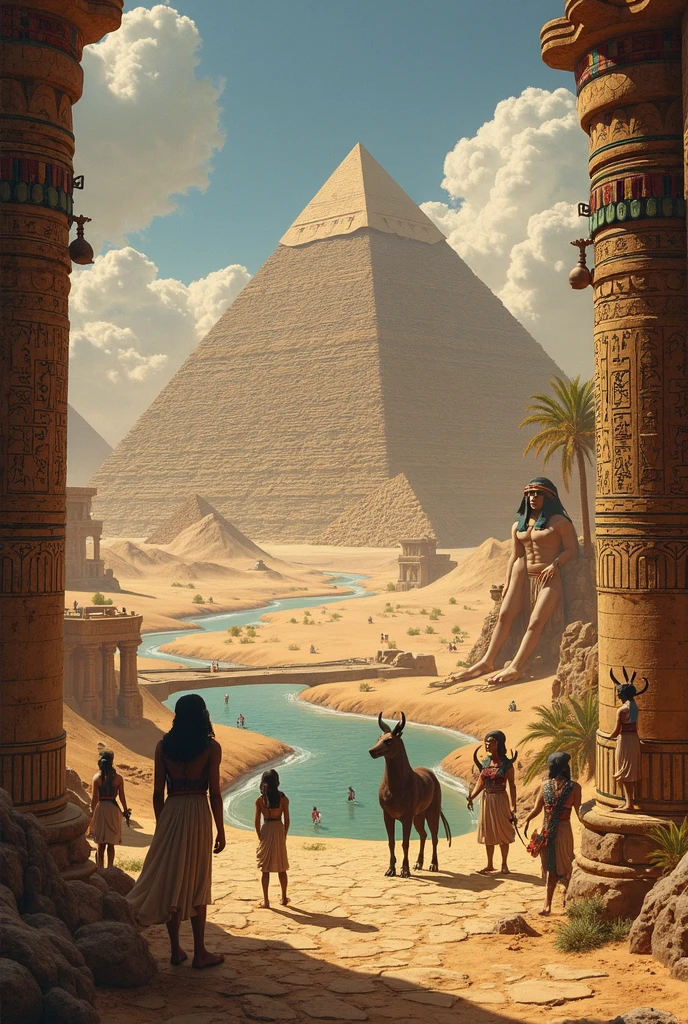Sumerian Mythology: The Pantheon and Its Deities
The ancient Sumerians, one of the earliest civilizations in Mesopotamia, developed a rich and complex mythology that influenced later cultures like the Babylonians and Assyrians. Central to their beliefs was the god Enlil, the ruler of the air and storms, who played a pivotal role in their cosmology. Alongside him, deities such as Anu, Inanna, and Marduk shaped their religious practices, while heroes like Gilgamesh became legendary figures. The Sumerians also built towering ziggurats as sacred temples to honor these gods.
The Sumerian Pantheon: Key Deities
The Sumerian pantheon was vast, with each deity governing different aspects of life and nature. Below is a table summarizing the most important gods and their domains:
| Deity | Role | Symbol |
|---|---|---|
| Anu | Sky god, king of the gods | Star or celestial disc |
| Enlil | God of air, wind, and storms | Horned crown |
| Inanna | Goddess of love, war, and fertility | Eight-pointed star |
| Marduk | Patron god of Babylon, later supreme deity | Dragon or serpent |
Enlil: The Supreme Authority
Enlil was one of the most powerful gods in Sumerian mythology, often considered second only to Anu. He was the lord of the air and storms, wielding immense power over both nature and humanity. According to myths, Enlil was responsible for the Great Flood, a story that later influenced the biblical tale of Noah.
Enlil’s Role in Sumerian Society
As the enforcer of divine will, Enlil was both feared and revered. His decisions shaped the fate of cities, and kings sought his favor to legitimize their rule. Key aspects of his influence included:
- Control over weather and agriculture
- Authority in divine councils
- Protector of sacred cities like Nippur
Anu: The Sky Father
Anu was the highest-ranking god in the Sumerian pantheon, ruling the heavens. Though less involved in earthly affairs than Enlil, his authority was unquestioned. Temples dedicated to Anu were often built atop ziggurats, symbolizing his celestial dominion.
Inanna: The Duality of Love and War
Inanna, later known as Ishtar, was a complex goddess embodying both love and war. Her myths, such as the Descent into the Underworld, highlight her fierce independence and power. She was also associated with the planet Venus.
Gilgamesh: The Legendary Hero
The Epic of Gilgamesh is one of the oldest surviving literary works, telling the story of King Gilgamesh of Uruk. His quest for immortality and friendship with Enkidu remains a cornerstone of Mesopotamian literature. Learn more about his adventures in this detailed analysis.
Marduk: The Rise of a New Supreme God
Originally a minor deity, Marduk rose to prominence during the Babylonian era. His victory over Tiamat in the Enuma Elish cemented his status as the chief god, replacing Enlil in later traditions.
Ziggurats: The Sacred Temples
Sumerians built massive ziggurats as temples to honor their gods. These stepped pyramids served as bridges between heaven and earth. The most famous include:
- The Ziggurat of Ur (dedicated to Nanna, the moon god)
- The Etemenanki (associated with Marduk in Babylon)
For a deeper dive into their architecture, visit The Met’s guide on ziggurats.
The Legacy of Sumerian Mythology
Sumerian myths laid the foundation for later Mesopotamian religions, influencing Babylonian, Assyrian, and even biblical stories. Their gods, like Enlil and Inanna, evolved but never faded from cultural memory.
Descubre más artículos fascinantes sobre mitología y sigue nuestras actualizaciones en facebook.com/zatiandrops.
In Sumerian mythology, the underworld, known as Kur or Irkalla, was a dark, gloomy realm ruled by the goddess Ereshkigal. Unlike later concepts of heaven and hell, the Sumerian afterlife was a neutral place where all souls—good or evil—resided eternally. The journey to Kur was perilous, requiring passage through seven gates, as described in Inanna’s Descent.
Ereshkigal: Queen of the Underworld
Ereshkigal, sister of Inanna, governed the underworld with absolute authority. Her consort, Nergal, the god of war and plague, later joined her as co-ruler. Myths depict her as merciless, yet her role was essential in maintaining cosmic balance.
Key Aspects of Ereshkigal’s Rule
- Judgment of the dead, though not based on morality
- Control over the Anunnaki, underworld deities
- Symbolized by the lapis lazuli scepter
The Anunnaki: Divine Judges of the Dead
The Anunnaki, a group of underworld deities, served as judges and administrators in Kur. Originally high-ranking gods, they were later associated with funerary rites. Their decisions determined a soul’s fate, though no paradise or punishment awaited—only a shadowy existence.
| Anunnaki Deity | Function |
|---|---|
| Namtar | Ereshkigal’s vizier, bringer of fate |
| Neti | Gatekeeper of the underworld |
| Dumuzid | Seasonal deity, Inanna’s doomed consort |
Sumerian cosmology began with the primordial union of Nammu, the goddess of the watery abyss, and An (Anu), the sky. Their offspring, including Enlil, shaped the universe. Two key epics—Enuma Elish (Babylonian) and the Eridu Genesis—detail these origins differently.
The Eridu Genesis: Sumerian Flood Narrative
Predating the biblical flood, the Eridu Genesis describes how the gods, weary of humanity’s noise, unleashed a deluge. Enlil orchestrated the disaster, but Enki warned the pious Ziusudra (Noah’s counterpart) to build an ark. This story highlights themes of divine wrath and mercy.
Parallels Between Ziusudra and Noah
- Both received divine warnings
- Survived in a sealed vessel
- Offered post-flood sacrifices
Sumerian religion was highly ritualistic, with priests (ensi) and priestesses mediating between gods and humans. The en, or high priest, often doubled as a city’s ruler, blending political and spiritual authority.
Temple Offerings and Festivals
Daily rituals included food offerings, libations, and incense to appease deities. Major festivals, like the Akitu (New Year), involved processions, reenactments of myths, and the symbolic marriage of Inanna and Dumuzid to ensure fertility.
Common Offerings to the Gods
- Barley, dates, and beer
- Sacrificial animals (lambs, bulls)
- Precious metals and textiles
Beyond the major gods, Sumerian mythology featured dozens of specialized deities overseeing crafts, diseases, and even kitchen utensils.
Nisaba: Goddess of Writing and Grain
Nisaba, patron of scribes, symbolized the intersection of agriculture and knowledge. Her worship declined when Nabu (Babylonian) replaced her as the god of writing.
Ningal: The Moon God’s Consort
Wife of Nanna (moon god), Ningal was a protective deity of Ur. Her laments over the city’s destruction are among the earliest poetic records of grief.
Sumerian gods often emerged through divine genealogy. For example:
- Anu + Ki (Earth) → Enlil
- Enlil + Ninlil → Nanna
- Nanna + Ningal → Utu (sun god) and Inanna
Sumerians feared utukku (demons) and relied on lamassu (winged guardians) for protection. Pazuzu, the wind demon, paradoxically warded off other evil spirits.
Exorcism and Magic
Priests performed elaborate exorcisms using incantations and figurines. The Maqlû series of spells aimed to repel curses, as recorded in this academic study.
Sumerian motifs permeated neighboring religions:
| Sumerian Deity | Babylonian/Assyrian Equivalent |
|---|---|
| Inanna | Ishtar |
| Enki | Ea |
| Utu | Shamash |
For further reading on cross-cultural parallels, explore this comparative analysis.
Descubre más artículos fascinantes sobre mitología y sigue nuestras actualizaciones en facebook.com/zatiandrops.
The Role of Animals in Sumerian Mythology
Animals held symbolic and divine significance in Sumerian beliefs, often serving as sacred companions or manifestations of gods. The lion, associated with Inanna, represented power and ferocity, while the bull symbolized strength and fertility, linked to Enlil and Nanna.
Sacred Animals and Their Deities
- Anzu bird – A divine storm creature, sometimes adversarial to the gods
- Snake – Embodied wisdom and healing, tied to Enki
- Scorpion people – Guardians of the sun god Utu
The Divine Artifacts of Sumerian Gods
Gods wielded powerful objects that defined their authority. Enlil’s Tablet of Destinies controlled cosmic order, while Inanna’s Me (divine decrees) governed civilization’s aspects like law and art.
| Artifact | Owner | Power |
|---|---|---|
| Tablet of Destinies | Enlil | Control over fate |
| Me | Inanna | Embodied cultural principles |
| Flood Tablet | Enki | Recorded the Great Deluge |
The Sacred Marriage Rite
The hieros gamos (sacred marriage) between Dumuzid and Inanna was central to fertility rituals. Kings reenacted this union to ensure agricultural abundance, reinforcing the bond between divinity and monarchy.
Stages of the Ritual
- Procession of the goddess’s statue to the temple
- Symbolic consummation by the king and high priestess
- Public feasting and offerings
Lesser-Known Sumerian Deities
Beyond the major gods, Sumer venerated niche figures like Ninkasi (goddess of beer) and Ninurta (god of farming and war). Their cults reflected everyday concerns, from harvests to craftsmanship.
Specialized Gods and Their Domains
- Gula – Goddess of healing and dogs
- Ishkur – Storm god, precursor to Adad
- Lahar – Cattle deity, sister of Ashnan (grain goddess)
Sumerian Astral Mythology
Celestial bodies were deified: Nanna (moon), Utu (sun), and Inanna (Venus). The Sumerians mapped constellations like MUL.APIN (“The Plow”), linking astronomy to agricultural cycles.
| Celestial Body | Deity | Symbolism |
|---|---|---|
| Moon | Nanna/Sin | Timekeeping, fertility |
| Sun | Utu/Shamash | Justice, truth |
| Venus | Inanna/Ishtar | Duality (morning/evening star) |
The Myth of Adapa and the Lost Immortality
In this tale, Adapa, a sage created by Enki, broke the wings of the south wind and was summoned to heaven. Offered the bread and water of immortality, he refused it on Enki’s advice, missing eternal life—a metaphor for human limitations.
Key Themes in the Adapa Myth
- Divine deception and human obedience
- The boundary between mortals and gods
- Wisdom as both gift and curse
Sumerian Demonology: The Seven Evil Spirits
Malevolent entities like the Sebettu brought disease and misfortune. Exorcisms invoked Enki or Ningishzida (a serpent god) to expel them. Protective amulets depicted Pazuzu, the demon-repelling demon.
Common Sumerian Demons
- Lilitu – Female night spirits (precursors to Lilith)
- Gallu – Underworld demons dragging victims to Kur
- Alû – Shadowy beings causing nightmares
The Influence of Sumerian Myths on Daily Life
From naming conventions (Ur-Nammu = “Warrior of Nammu”) to legal codes invoking Utu’s justice, mythology permeated Sumerian society. Even city layouts mirrored cosmic order, with temples as axis mundi.
Examples of Mythological Impact
- Kingship legitimized through divine election
- Medical texts attributing illness to demonic forces
- Proverbs referencing gods (e.g., “Inanna’s will is unchangeable”)
Descubre más artículos fascinantes sobre mitología y sigue nuestras actualizaciones en facebook.com/zatiandrops.
The Role of Women in Sumerian Religion
Women held significant religious authority in Sumerian society, serving as high priestesses, oracles, and even deified queens. The Enheduanna, daughter of Sargon of Akkad, was history’s first named author and high priestess of Nanna at Ur. Her hymns to Inanna blended politics with devotion.
Notable Female Religious Figures
- Enheduanna – Priestess-poetess who composed temple hymns
- Kubaba – Only queen on the Sumerian King List, later deified
- Nadītu – Class of celibate priestesses managing temple estates
The Musical Dimension of Sumerian Worship
Music was integral to Sumerian rituals, with instruments like the lyre and balag (harp) accompanying hymns. The Gudea Cylinders describe temple orchestras performing for gods, while Ninkasi’s beer hymns doubled as brewing instructions.
| Instrument | Divine Association | Archaeological Evidence |
|---|---|---|
| Silver Lyre of Ur | Used in Inanna’s cult | Found in Royal Cemetery (2600 BCE) |
| Balag Drum | Voice of the gods | Depicted in cylinder seals |
Sumerian Creation of Humanity Myths
Multiple accounts exist of humanity’s origin. In one version, Enki and Ninhursag fashioned humans from clay mixed with divine blood. Another describes the Anunnaki creating laborers to till the gods’ fields, explaining humanity’s servile role.
Variations in Creation Stories
- Eridu Genesis – Humans as divine afterthought
- Enki and Ninmah – Creation of disabled humans as divine jest
- Atrahasis Epic – Rebellion leading to human creation
The Concept of Divine Me (Universal Decrees)
The Me were sacred principles governing civilization, stolen by Inanna from Enki in a famous myth. Over 100 Me existed, including:
- Kingship
- Truth
- Sexual intercourse
- Weaving
- Metalworking
Sumerian Views on Death and Burial Practices
Royal tombs like the Death Pits of Ur reveal elaborate funerary rites. Servants were buried with rulers, and corpses were positioned facing west – the direction of the setting sun and the underworld. Grave goods included:
- Cylinder seals (divine identification)
- Game boards (entertainment in afterlife)
- Gold headdresses (status markers)
The Evolution of Sumerian Gods in Later Periods
As political power shifted to Babylon, deities transformed:
| Sumerian God | Babylonian Transformation | Key Changes |
|---|---|---|
| Enki | Ea | Greater emphasis on magic |
| Inanna | Ishtar | More warlike aspects |
| Utu | Shamash | Stronger solar justice role |
Sumerian Temple Economies
Temples functioned as economic centers, managing:
- Granaries and food distribution
- Craft workshops (textile, metal)
- Land leases and labor organization
The ensi (priest-king) oversaw these operations, with scribes recording transactions in cuneiform on clay tablets – some of the earliest accounting records.
The Legacy of Sumerian Demonology
Sumerian evil spirits influenced later traditions:
- Lilitu → Hebrew Lilith
- Gallu → Greek Galli (underworld spirits)
- Pazuzu → Assyrian protective demon
Descubre más artículos fascinantes sobre mitología y sigue nuestras actualizaciones en facebook.com/zatiandrops.


